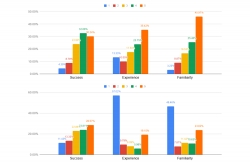This time I chose to present a list of choice performance indicators used (or that should be used) in most companies, in order to measure improvement processes in various fields, from production to customer-service. We'll begin with the following four.
Even though every company is a unique entity with particular characteristics, some general indicators can benefit every company – if management is willing to invest the necessary time, priority and effort.
At the end of this article I include a link to a large international website containing a list of dozen of indicators and how to use them.
Recommended frequency for discussion of indicators: I recommend all indicators' results be discussed by management once a month. At least once a week, they should be discussed in dedicated improvement teams with the relevant manager (operations, sales, finance, marketing, etc.) or their representative. Some indicators should be shortly analyzed daily, as needed.
4 Important Indicators Every Manager Should Know
- Sales. The most important index is sales. More accurately, scope of sales compared to budget. You should of course break-down your yearly plan per month, and have a monthly sales goal.
I suggest you examine sales progress weekly, comparing it to the plan and making sure the monthly goal is achieved. In addition you should also discuss plans for upcoming weeks. The team which discusses this index should include representatives from sales as well as other departments, in order to bring to the table all problems in the sales process.
It is recommended you publish a daily performance report, showing progress in orders received and in shipments compared to the yearly and monthly plans. This way you'll be able to achieve better focus in a wide forum. - Supply time-tables. This is one of the main challenges in the local industry. A company that's able to supply products in the agreed upon time-table and quickly will have more orders. That is a considerable competitive advantage. These days many companies are unable to comply with supply deadlines. I suggest the operations manager hold a weekly one-hour review meeting, with a team of his employees and a representative from sales and the production planning and control manager (if that role is not part of the operations department), to analyze the reasons for not meeting supply deadlines.
Once a month, this index should be discussed by management, along with the other indicators. - Following a weekly production plan. Following a production plan is a corner stone of meeting supply deadlines. Most companies don’t have a weekly production plan. It's difficult to overstate its importance, despite the difficulty in starting to work with one.
Monitoring the production plan should by thusly: in order to calculate this index you should compare the planned production from the previous week with the actual production. Follow this formula: 1 minus the total difference in absolute value between plan and performance, divided by the total amount produced.
Preparing a weekly production plan, and following it, enables you to order and maintain the necessary inventory of raw materials and packaging. With no expanses on urgent and unplanned deliveries due to missing materials, and without dead inventory. In addition, a weekly plan enables you to organize work and employees, and easily and effectively manage resources and equipment. This index should be examined weekly and monthly, like the above, as well as a short daily check.
Analyzing the reasons behind not following the weekly plan makes it possible to improve essential root causes which cause problems with meeting production goals. - Inventory compliance. This too is a very important index, beyond warehouse management.
Monitoring: once a week you should randomly check 5-10 items in the warehouse, and compare the actual amount with the amount recorded in the inventory management system. To get the result, divide the number of items with total compliance by the total items (catalogue numbers) checked.
Each time, analyze root causes for some of the differences, if there were any. This analysis will highlight many issues to be improved, usually on the production floor and in the management of product-trees. Monitoring and analysis should be conducted weekly and monthly – in the management meeting which discusses these indicators.
As promised, here is a link to Oliver Wight's website, where you can find a list of dozens of indicators. You'll need to subscribe, but it's free and they don’t send spam mail. Recommended.
If you are interested in my professional help, personally or for your company, the best way is to send a request through the Get in Touch form in my website (here).












 My First Book: Manage! Best Value Practices for Effective Management
My First Book: Manage! Best Value Practices for Effective Management